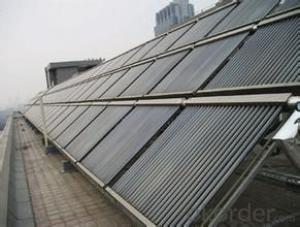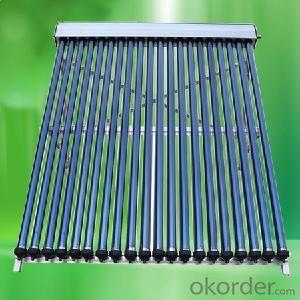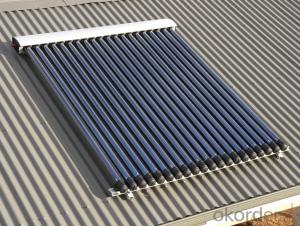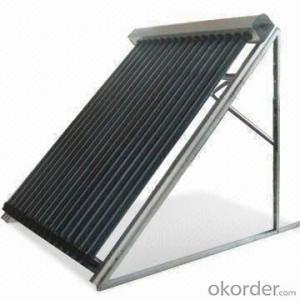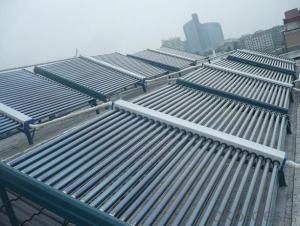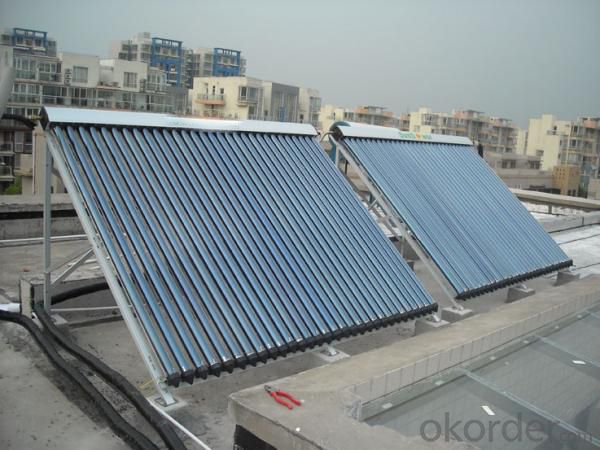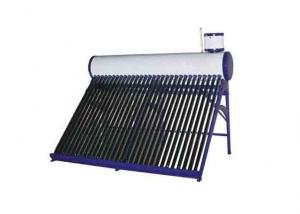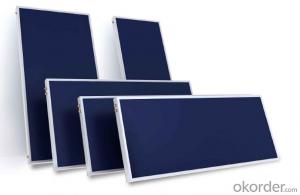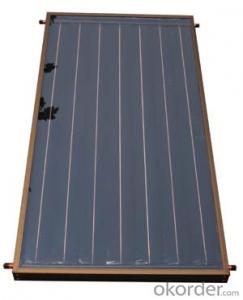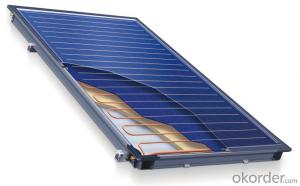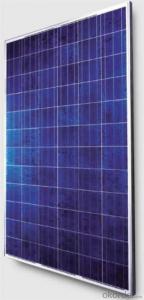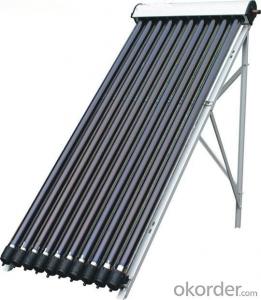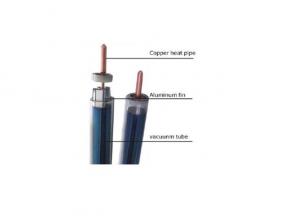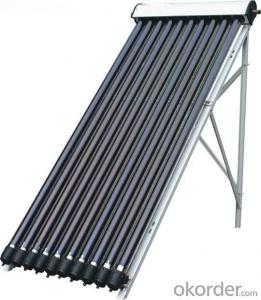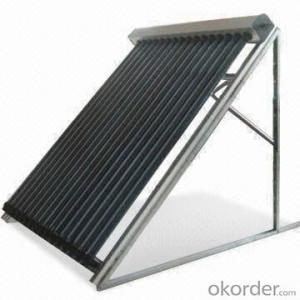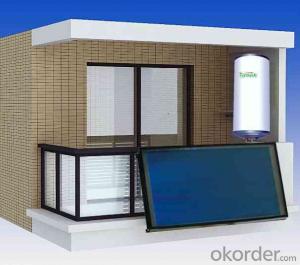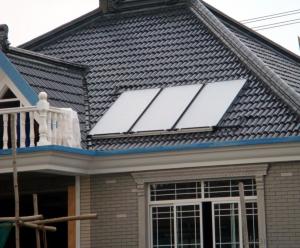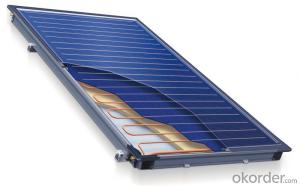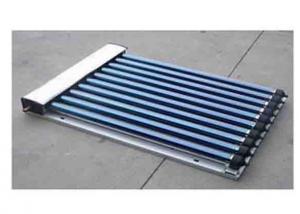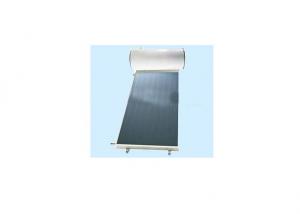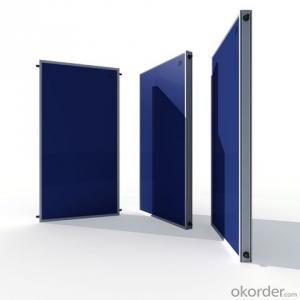Pearson Solar Collectors - Heat Pipe Vacuum Tubes with Certificate
- Loading Port:
- China main port
- Payment Terms:
- TT OR LC
- Min Order Qty:
- 5 set
- Supply Capability:
- 10000 set/month
OKorder Service Pledge
OKorder Financial Service
You Might Also Like
Specifications
manifold (inner) | red copper |
manifold (exterior) | aluminum alloy |
glass tube dimensions | 58mm * 1800mm |
daily efficiency | ≥55% |
heat preservation | 72 hours |
hail resistance | 25mm |
max pressure | 7 bar |
coating of vacuum tube | ALN/AIN-SS/CU |
heat pipe | anti-freezing > -35 degree |
certificate | Solar Keymark, EN12975,SRCC |
Serious Product
Models | L*W*H mm | Vacuum tube | Power output | Efficiency | Header mm | Frame | container loading 20FT/40HQ sets | Gross Weight kg |
SHC-8 | 1917*910*133 | 58*1800*8pcs | 939W | 0.668 | Φ35/1.0 | AL alloy | 185/445 | 27 |
SHC-10 | 1917*1130*133 | 58*1800*10pcs | 1189W | 159/385 | 33 | |||
SHC-12 | 1917*1350*133 | 58*1800*12pcs | 1440W | 149/358 | 40 | |||
SHC-15 | 1917*1680*133 | 58*1800*15pcs | 1815W | 120/290 | 49 | |||
SHC-18 | 1917*2010*133 | 58*1800*18pcs | 2191W | 100/242 | 59 | |||
SHC-20 | 1917*2230*133 | 58*1800*20pcs | 2442W | 87/210 | 66 | |||
SHC-22 | 1917*2450*133 | 58*1800*22pcs | 2692W | 83/202 | 72 | |||
SHC-24 | 1917*2670*133 | 58*1800*24pcs | 2943W | 77/188 | 79 |
Packaging & Delivery
Packaging Details: | Exporting Carton with big foaming protection |
Delivery Detail: | In 10-15 days |
Loading Quantity
Model | Tube | Tube Q.T.Y | Loading Q.T.Y/40HQ |
GSC15 | 58*1800mm | 15pcs | 315sets |
GSC18 | 58*1800mm | 18pcs | 265sets |
GSC20 | 58*1800mm | 20pcs | 248sets |
GSC22 | 58*1800mm | 22pcs | 225sets |
GSC25 | 58*1800mm | 25pcs | 200sets |
GSC30 | 58*1800mm | 30pcs | 168sets |
Principle of solar collector:
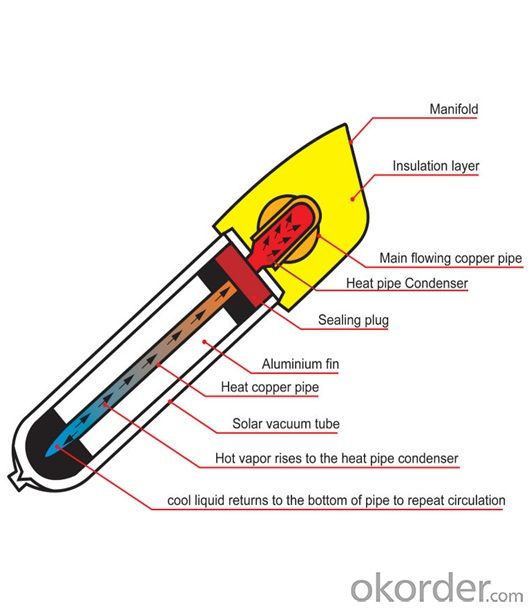

Solar collector details
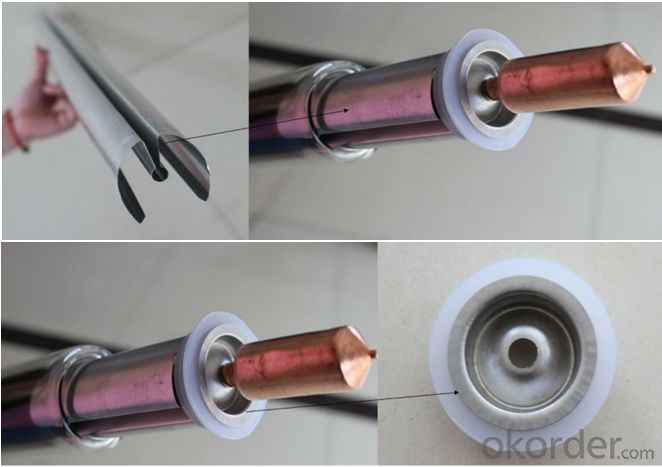

- Q: Are there any fire risks associated with solar collectors?
- Yes, there are some fire risks associated with solar collectors. While solar collectors themselves do not pose a direct fire risk, the electrical components and wiring used in solar panel systems can potentially cause fires if not installed or maintained properly. Overheating, faulty wiring, or electrical malfunctions can lead to fires in rare cases. However, when installed and maintained by qualified professionals following safety guidelines, the risk of fire from solar collectors is minimal.
- Q: Are there any financial benefits to installing solar collectors?
- Yes, there are several financial benefits to installing solar collectors. Firstly, solar collectors can significantly reduce or even eliminate monthly electricity bills by generating free and renewable energy from the sun. Additionally, homeowners who install solar collectors may be eligible for various government incentives, such as tax credits or rebates, which can help offset the initial installation costs. Moreover, if the solar collectors produce more energy than is consumed, the excess can be sold back to the grid, allowing homeowners to earn credits or even receive payments from their utility company. Overall, installing solar collectors can lead to long-term savings, increased property value, and a return on investment over time.
- Q: How do solar collectors impact energy independence?
- Solar collectors have a profound impact on achieving energy independence through the provision of a clean and renewable power source. By harnessing the energy from the sun, solar collectors generate electricity or heat, thereby reducing the need for non-renewable resources like fossil fuels. The ability of solar collectors to generate electricity off-grid is one of their key advantages. This allows individuals, communities, and even entire countries to become more self-sufficient in meeting their energy needs. Even in remote areas or regions with limited access to traditional power grids, solar collectors provide a reliable source of electricity, reducing dependence on external energy sources. Furthermore, solar collectors contribute to energy independence by decreasing reliance on imported energy resources. Many countries heavily rely on imported fossil fuels, which not only incur significant costs but also expose them to political and economic uncertainties. Investing in solar collectors allows countries to decrease their dependence on such imports, enhancing energy security and reducing vulnerability to price fluctuations or disruptions in the global energy market. Solar collectors also promote energy independence at the individual level. Homeowners and businesses that install solar panels can generate their own electricity, reducing the need to purchase electricity from the grid. In some cases, surplus energy produced by solar collectors can even be sold back to the grid, enabling individuals to become energy producers rather than mere consumers. Moreover, solar collectors contribute to the reduction of carbon emissions and the fight against climate change. By replacing fossil fuel-based electricity generation with solar power, there is a significant decrease in greenhouse gas emissions, particularly carbon dioxide. This transition to cleaner energy sources not only protects the environment but also reduces dependence on finite resources that contribute to climate change. In conclusion, solar collectors play a crucial role in promoting energy independence. By harnessing the sun's energy, they provide a clean, renewable, and reliable power source, reducing dependence on non-renewable energy sources, minimizing reliance on imported energy, and contributing to a more sustainable and secure energy future.
- Q: Can solar collectors be used in automotive manufacturing?
- Yes, solar collectors can be used in automotive manufacturing. They can be employed to generate renewable energy for powering various systems and processes in the manufacturing facilities, reducing reliance on traditional energy sources and decreasing carbon emissions. Additionally, solar collectors can be integrated into electric vehicle charging infrastructure, providing a clean and sustainable way to power electric vehicles during the manufacturing process.
- Q: Can solar collectors be used in conjunction with other renewable energy sources?
- Yes, solar collectors can be used in conjunction with other renewable energy sources. Many renewable energy systems, such as hybrid solar-wind or solar-hydro, combine solar collectors with other sources to enhance energy production and reliability. This integrated approach allows for a more diverse and sustainable energy mix, maximizing the benefits of multiple renewable sources.
- Q: How do solar collectors handle temperature fluctuations?
- Solar collectors are designed to handle temperature fluctuations by incorporating various components and materials that can withstand and adapt to changing temperatures. These collectors typically contain a heat-absorbing plate or tube, which is made of materials with high thermal conductivity and low thermal expansion coefficients. This allows the collector to efficiently absorb heat from sunlight and transfer it to a heat transfer fluid or storage medium without being damaged by temperature changes. Additionally, some collectors are equipped with insulation materials to minimize heat losses and maintain a more stable temperature within the system. Overall, solar collectors are engineered to effectively handle temperature fluctuations to ensure optimal performance and durability.
- Q: Can solar collectors be used for water desalination?
- Yes, solar collectors can be used for water desalination. Solar thermal desalination systems utilize solar energy to heat water, creating steam which is then condensed to produce clean, fresh water. This sustainable and environmentally friendly method is increasingly being explored as a viable solution to address water scarcity issues in coastal regions.
- Q: Can solar collectors be used for heating cultural centers and theaters?
- Yes, solar collectors can be used for heating cultural centers and theaters. Solar thermal collectors can capture the sun's energy and convert it into heat, which can then be used to provide heating for indoor spaces. This renewable energy source can effectively contribute to the heating needs of cultural centers and theaters, offering a sustainable and environmentally friendly solution.
- Q: Can solar collectors be used for heating airports and transportation hubs?
- Yes, solar collectors can be used for heating airports and transportation hubs. Solar thermal systems can generate heat by capturing and utilizing solar energy, which can be used for space heating, water heating, and even heating of large buildings and facilities such as airports and transportation hubs. This renewable energy source can help reduce reliance on fossil fuels, lower carbon emissions, and contribute to a more sustainable and environmentally friendly heating solution for these high-energy consumption areas.
- Q: Can solar collectors be used to generate electricity in remote locations?
- Yes, solar collectors can be used to generate electricity in remote locations. Solar collectors, such as solar panels, can convert sunlight into electricity through the photovoltaic effect. This means that as long as there is sufficient sunlight, solar collectors can generate electricity regardless of the location, making them an ideal and sustainable solution for remote areas that lack access to traditional power grids.
Send your message to us
Pearson Solar Collectors - Heat Pipe Vacuum Tubes with Certificate
- Loading Port:
- China main port
- Payment Terms:
- TT OR LC
- Min Order Qty:
- 5 set
- Supply Capability:
- 10000 set/month
OKorder Service Pledge
OKorder Financial Service
Similar products
Hot products
Hot Searches
Related keywords

